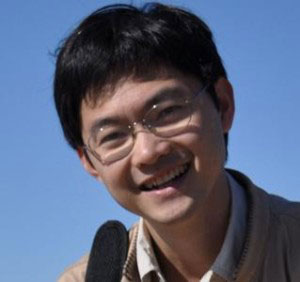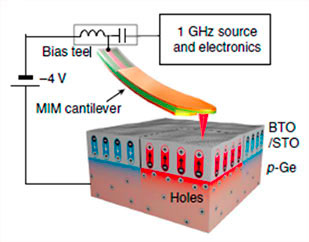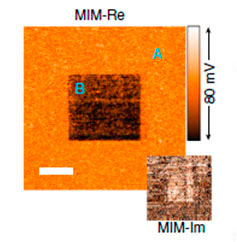Next Generation Ferroelectric Memory Of Buried Ge In An FeFET Structure

Professor Keji Lai was instrumental in the development of the MIM technique. His contribution started when he was a postdoctoral scholar in the Shen Lab at Stanford University, and continues as an Assistant Professor of Physics at the University of Texas at Austin today. His group, Nanoscale ElectroMagnetic Lab – The Lai Research Group at UT-Austin, is advancing the state of sMIM based research and here we present one of the many important recent research they published.
This December 2014 journal article discussed how sMIM was used to provide key evidence for the change in conductivity of the germanium substrate induced by the polarization state of an adjacent ferroelectric layer. The results in this paper are an important step towards ferroelectric memory technology. An excerpt of the article is reproduced here:
Carrier Density Modulation in a Germanium Heterostructure by Ferroelectric Switching
By Ponath, Patrick, et al. Nature communications 6 (2015)
The development of non-volatile logic through direct coupling of spontaneous ferroelectric polarization with semiconductor charge carriers is nontrivial, with many issues, including epitaxial ferroelectric growth, demonstration of ferroelectric switching and measurable semiconductor modulation. Here we report a true ferroelectric field effect—carrier density modulation in an underlying Ge(001) substrate by switching of the ferroelectric polarization in epitaxial c-axis-oriented BaTiO3 grown by molecular beam epitaxy. Using the density functional theory, we demonstrate that switching of BaTiO3 polarization results in a large electric potential change in Ge. Aberration-corrected electron microscopy confirms BaTiO3 tetragonality and the absence of any low-permittivity interlayer at the interface with Ge. The non-volatile, switchable nature of the single-domain out-of-plane ferroelectric polarization of BaTiO3 is confirmed using piezoelectric force microscopy. The effect of the polarization switching on the conductivity of the underlying Ge is measured using microwave impedance microscopy, clearly demonstrating a ferroelectric field effect.
Figure 1 below shows a schematic drawing illustrating the sMIM measurement set-up and configuration of the sample. Lai’s group was able to verify the conductivity change of the Ge substrate when the ferroelectric polarization of the epitaxial BTO layer is switched by a -4V bias on the conductive shielded probe, as shown in Figure 2.

Figure 1. Schematic drawing of the sMIM setup and sample configuration

Figure 2. MIM-Re and –Im (lower right corner) images of the BTO-Ge sample, in which the inner 20mm ´ 20mm area was poled by a previous scan with -4V on a conductive probe. The carrier modulation due to ferroelectric switching is verified by the clear contrast in the MIM data.
The groundbreaking research and recent publications of the Lai Group, which is led by Dr. Keji Lai, continues to demonstrating the importance of Scanning Microwave Impedance Microscop (sMIM) to the research community, both for advanced materials research and commercial applications. Recent highlights will be presented in seven separate talks at the March meeting of the American Physical Society.
For more information about their research, please visit Nanoscale ElectroMagnetic Lab – The Lai Research Group at UT-Austin.
A sample list of recent publications of the Lai Group:
- Ponath, Patrick, et al. “Carrier density modulation in a germanium heterostructure by ferroelectric switching.” Nature communications 6 (2015).
- EETimes – FeFET to Extend Moore’s Law, R. Colin Johnson, 1/15/15 http://nanotechweb.org/cws/article/tech/57979
- Nanotechweb.org – Molybdenite defects go mesoscale http://www.eetimes.com/document.asp?doc_id=1325307
- Y. Liu, et al. Mesoscale Imperfections in MoS2 Atomic Layers Grown by a Vapor Transport Technique, Nano Lett. 2014, 14, 4682−4686
- J-S Kim et al. Toward Air-Stable Multilayer Phosphorene Thin-Films and Transistors, arXiv:1412.035
Copyright 2024. All Rights Reserved
